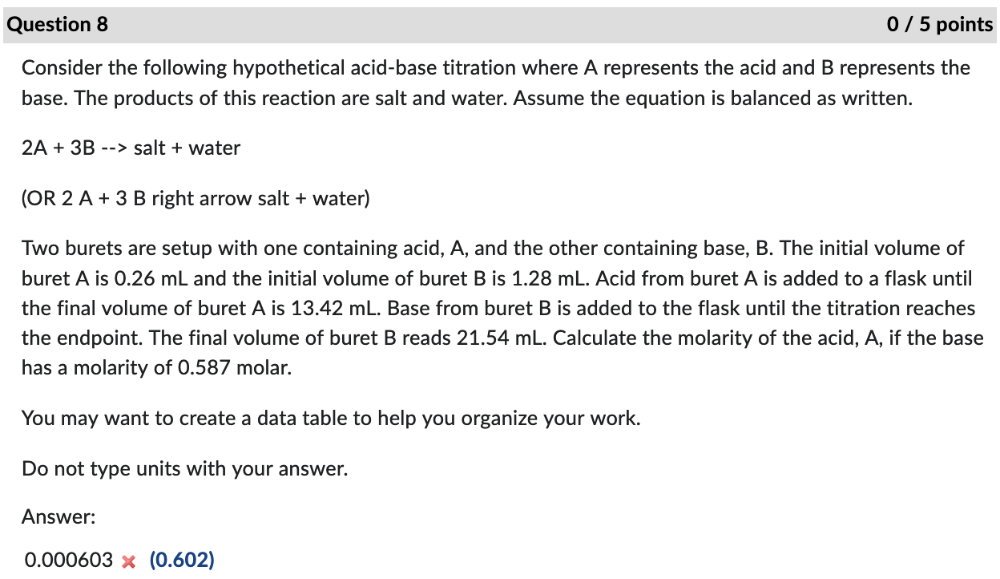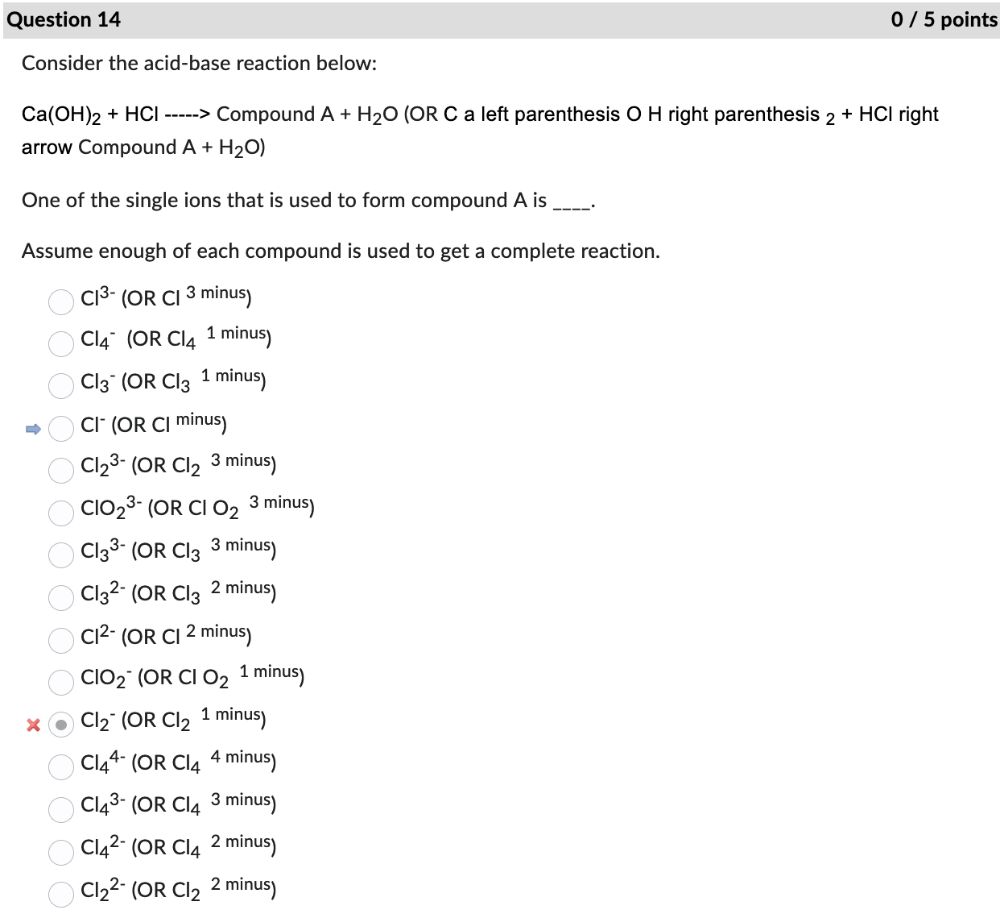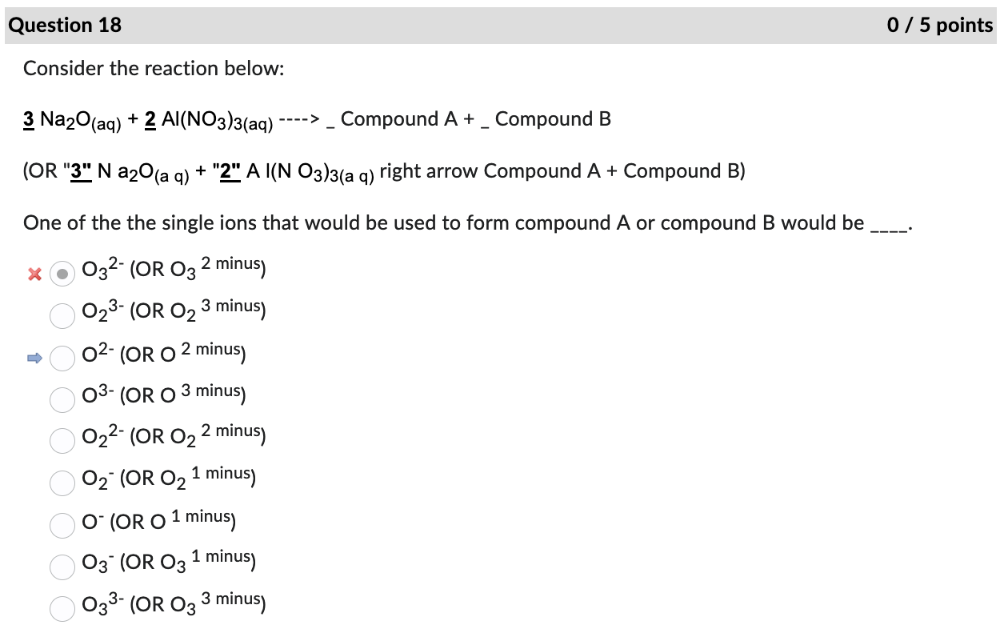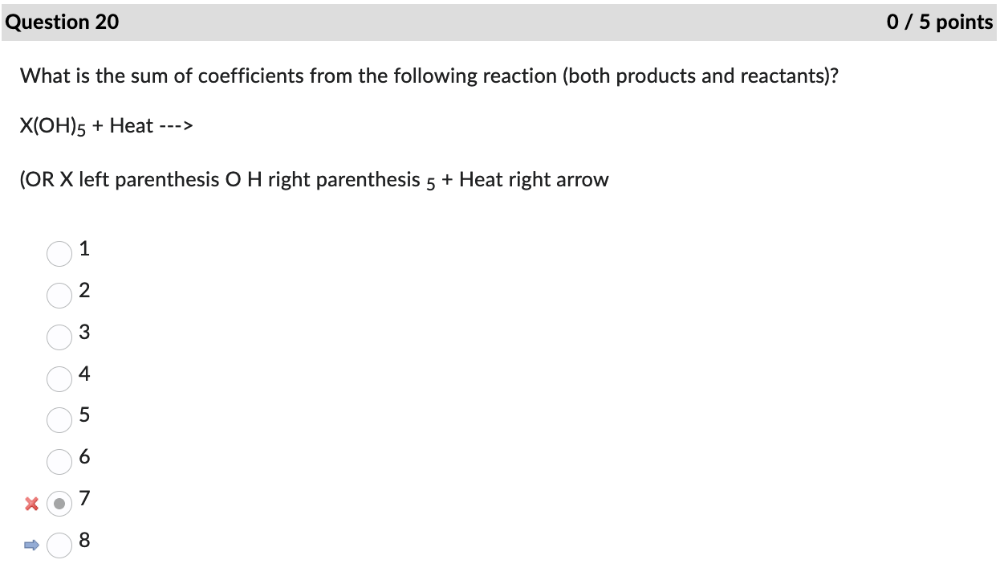How many grams of NaCl (OR "N" a Cl) would be required to prepare a 0.460 M solution with a volume of 323.00 mL?
Do not type units with your answer.
323.00 mL x (0.460 M / 1000 mL) = 0.149 mol NaCl
Molar Mass of NaCl = (Na-22.990 + Cl-35.453) = 58.443
0.149 mol NaCl x (58.443 g NaCl / 1 mol NaCl) = 8.71
Calculate the solution volume in mililiters of a 5.59 M solution containing 1.62 moles of solute.
Do not type units with your answer.
290
How many grams of AgNO3 (OR Ag "N" O3) would be required to prepare a 0.37 M solution with a volume of 222.00 mL?
Do not type units with your answer.
14
How many grams of NaC2H3O2 (OR "N" a C2 H3 O2) would be required to prepare a 0.99 M solution with a volume of 920.00 mL?
Do not type units with your answer.
75
Calculate the mass percent of a solution containing 74.03 grams of solute and 864.36 grams of water.
Do not type units with your answer
7.889
Consider the following hypothetical acid-base titration where A represents the acid and B represents the base. The products of this reaction are salt and water. Assume the equation is balanced as written.
A + 2B --> salt + water
(OR A + 2 B right arrow salt + water)
Calculate the molarity of B if 14.39 mL of A with a molarity of 0.208 is titrated with 19.96 mL of B.
Do not type units with your answer.
0.300
Consider the following hypothetical acid-base titration where A represents the acid and B represents the base. The products of this reaction are salt and water. Assume the equation is balanced as written.
A + B --> salt + water
(OR A + B right arrow salt + water)
Calculate the molarity of B if 13.35 mL of A with a molarity of 0.295 is titrated with 17.25 mL of B.
Do not type units with your answer.
0.228
Consider the following hypothetical acid-base titration where A represents the acid and B represents the base. The products of this reaction are salt and water. Assume the equation is balanced as written.
2A + 3B --> salt + water
(OR 2 A + 3 B right arrow salt + water)
Two burets are setup with one containing acid, A, and the other containing base, B. The initial volume of buret A is 0.26 mL and the initial volume of buret B is 1.28 mL. Acid from buret A is added to a flask until the final volume of buret A is 13.42 mL. Base from buret B is added to the flask until the titration reaches the endpoint. The final volume of buret B reads 21.54 mL. Calculate the molarity of the acid, A, if the base has a molarity of 0.587 molar.
You may want to create a data table to help you organize your work.
Do not type units with your answer.

0.000603
Consider the following hypothetical chemical equation
A + 2B --> AB2
(OR A + 2 B right arrow A B2)
Calculate the mass in grams of AB2 produced from the reaction of 132.48 mL of 0.428 M B with an excess amount of A.
The atomic weight of A is 30 grams/mole
The atomic weight of B is 50 grams/mole
3.69
Consider the reaction below:
3 MgCrO4(aq) + 2 FeCl3(aq) ----> 1 Fe2(CrO4)3( s) + 3 MgCl2 (aq)
(OR 3 MgCrO4(a q) + "2" F eCl3(a q) right arrow "1" F e2(Cr O4)3( s) + 3 MgCl2 (a q))
The sum of the coefficients of the full ionic equation is
24
Consider the reaction below:
Fe(NO3)3 (aq) + 1 Na3PO4(aq) ----> 1 FePO4(s) + 3 NaNO3(aq)
(OR F e(N O3)3 (a q) + "1" N a3P O4(a q) ----> "1" F e P O4(s) + "3" NaNO3(a q))
The sum of the coefficients of the full ionic equation is
15
Consider the reaction below:
Pb(NO3)4 (aq) + 2 Mg(OH)2(aq) ----> Pb(OH)4(s) + 2 Mg(NO3)2(aq)
(OR Pb(N O3)4 (a q) + 2 Mg(O H)2(a q) right arrow Pb(O H)4(s) + 2 Mg(N O3)2(a q)
The sum of the coefficients of the net ionic equation is
6
Consider the reaction below:
3 MgCrO4(aq) + 2 FeCl3(aq) ----> 1 Fe2(CrO4)3( s) + 3 MgCl2 (aq)
(OR 3 MgCrO4(a q) + "2" F e Cl3(a q) right arrow "1" F e2(Cr O4)3( s) + "3" MgCl2 (a q)
The sum of the coefficients of the net ionic equation is
6
Consider the acid-base reaction below:
Ca(OH)2 + HCl -----> Compound A + H2O (OR C a left parenthesis O H right parenthesis 2 + HCl right arrow Compound A + H2O)
One of the single ions that is used to form compound A is ____.
Assume enough of each compound is used to get a complete reaction.

Cl2 - (OR Cl2 1 minus)
Consider the acid-base reaction below:
Mg(OH)2 + H3PO4 ----> __Compound A + H2O (OR Mg left parenthesis OH right parenthesis 2 + H3PO4 right arrow __Compound A + H2O)
One of the single ions that is used to form compound A is ____.
Assume enough of each compound is used to get a complete reaction.
PO4 3- (OR P O4 3 minus)
Consider the reaction below:
3 Pb(NO3)2(aq) + 2 AlBr3(aq) ----> _ Compound A + _ Compound B
(OR " 3" Pb(N O3)2(a q) + " 2" AlBr3(a q) right arrow Compound A + Compound B)
One of the the single ions that would be used to form compound A or compound B would be ____.
NO3 - (OR N O3 1 minus)
Consider the reaction below:
Pb(NO3)4(aq) + 4 NaOH(aq) ----> _ Compound A + _ Compound B
(OR Pb(N O3)4(a q) + " 4" N a O H(a q) ----> Compound A + Compound B)
One of the the single ions that would be used to form compound A or compound B would be ____.
OH- (OR OH 1 minus)
Consider the reaction below:
3 Na2O(aq) + 2 Al(NO3)3(aq) ----> _ Compound A + _ Compound B
(OR " 3" N a2O(a q) + " 2" A l(N O3)3(a q) right arrow Compound A + Compound B)
One of the the single ions that would be used to form compound A or compound B would be ____.

O3 2- (OR O3 2 minus)
What is the sum of coefficients from the following reaction (both products and reactants)?
X(CO3)3 + Heat --->
(OR X(C O3)3 + Heat right arrow
5
What is the sum of coefficients from the following reaction (both products and reactants)?
X(OH)5 + Heat --->
(OR X left parenthesis O H right parenthesis 5 + Heat right arrow

7
What is the sum of coefficients from the following reaction (both products and reactants)?
X.6H2O + Heat --->
(OR X dot 6 H2O + heat right arrow
8
What is the oxidation number of S in H2SO4 (OR H2 S O4)?
+ 6
What is the oxidation number of O in O2?
0
What is the oxidation number of K in KMnO4 (OR K Mn O4)?
+ 1